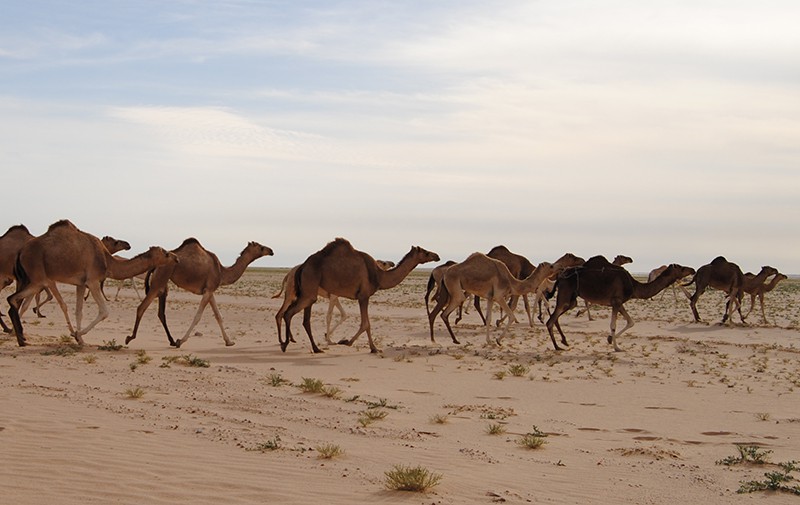
Origin
Despite its association with the desert landscape of North Africa, the origin of the camel is actually much closer to home. Members of the Camelidae family—which includes llamas, vicuñas, alpacas, guanacos, and camels—evolved in North America over 46 million years ago, and fossilized remains of these early camel ancestors have been discovered across the continent from Alaska to Florida. Three to four million years ago, these early camels migrated across the Bering Strait land bridge into Siberia, eventually working their way into the rest of Asia, Europe, and the Middle East. In Asia, camelids separated into two distinct groups: the one-humped, or dromedary, camel found in the Arabian deserts, and the two-humped Bactrian camel, which lives in Central and East Asia.
As a result of the ice age, hunters, and disease, camels disappeared from North America around ten thousand years ago and have only returned very recently as circus, zoo, and now dairy animals.
History
Like its equine cousin, the camel was probably domesticated around 3000 BC. Thanks to its uncanny ability to survive on scant rations of both food and water, the camel soon became the pack animal of choice for traders making the long and arduous journey from southern Arabia to the northern regions of the Middle East. From a beast of burden, the camel eventually developed into many desert dwellers’ primary source of not only transportation, but also milk, meat, wool, and hides. For some cultures, such as the nomadic Bedouin tribes of the Arabian Peninsula, the camel represents both a means of survival in a harsh climate and a symbol of independence and self-reliance.
Appearance & Temperament
One of the most archetypal of desert creatures, the camel possesses an elegant anatomy that exemplifies evolutionary adaptation to the harsh and unforgiving environment it often inhabits. Its small, fur-lined ears; double eyelashes; and large, muscular nostrils that can be opened and closed at will help it to cope with high winds and blowing sand while its flat, leathery feet spread wide to prevent it from sinking into the soft footing of the world’s great deserts.
Contrary to popular belief, camels do not actually store water in their humps. A camel’s hump is made up of fatty tissue that provides an essential source of energy when food is scarce. Thanks to this unique energy storage solution, camels can survive for long periods of time—up to a week—on hardly any food or water.
Gil Riegler, owner of Oasis Camel Dairy in Ramona, California—the only camel dairy in the U.S.—explains that, despite their reputation for being bad-tempered and obstinate, camels respond to the way they are treated. “Treat them well and they become your best friends,” he says. “Camels really are like big dogs. They don’t have predators in the wild, so they don’t spook like a horse would, and this allows you to work with them intelligently. Once a camel trusts you, she will do anything for you.”
Milk & Cheeses
Riegler and his wife, Nancy, have been working with and gathering milk from their own herd of Southern California camels for more than 20 years. According to the Rieglers, camel’s milk is a very close mimic of human breast milk and can even be used by mothers as a milk replacement. Camel’s milk also contains triple the amount of vitamin C and ten times the amount of antibacterial and antiviral factors found in cow’s milk. Plus, adds Gil, “it tastes great, very light, just sweet enough, no aftertaste and there are no allergies to it whatsoever.”
While Gil and Nancy have made a delicious cream cheese from their camels’ milk, they have not yet experimented with hard cheeses. “From what I understand, you can make hard cheeses but you need to use additives,” says Gil.
While U.S. law currently forbids the selling of camel’s milk (only people who own camels can consume the milk), Gil firmly believes that camel’s milk will eventually become available in the U.S. market. “When we started milking camels 15 years ago, no one had heard about it, but now, after years of educating the public and so many TV appearances, we now mention the words ‘camel’s milk’ and people say that they heard that camels are actually very sweet animals and that their milk is very good for you. That’s a big change!”
Interested in the efforts of camel dairies to create a plausible and delicious hard camel’s cheese and the wonder of camel milk enzymes? Take a look at Phillipa Young’s sidebar, “Camel dairy in your cheese?”






One thought on “Dromedary Cattle”